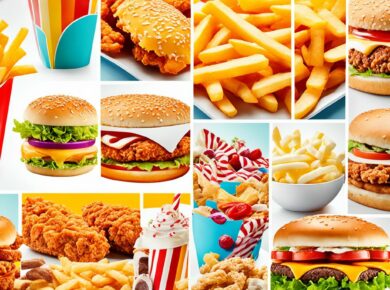Welcome to our comprehensive guide on understanding eating disorders. In this article series, we aim to dispel the myths surrounding eating disorders, shed light on their complexities, and provide valuable insights into their impact on mental health and body image.
Eating disorders are often misunderstood, creating barriers to effective treatment and support. Contrary to popular belief, these conditions are not solely about food or appearance. They are complex mental health disorders that can affect individuals of any gender, age, or background.
It’s essential to recognize that eating disorders involve more than just body image and weight concerns. Comprehensive treatment is necessary to address both the physical and psychological aspects of these disorders. By debunking misconceptions, we can promote understanding and help those affected by these serious conditions.
Common Myths about Eating Disorders
There are several common misconceptions and myths surrounding eating disorders that hinder our understanding and ability to provide help to those in need. Let’s unravel these misconceptions and shed light on the reality of eating disorders.
- Myth: Only girls have eating disorders.
Contrary to popular belief, eating disorders do not discriminate based on gender. They can affect individuals of all genders, ages, and backgrounds. It is essential to recognize that eating disorders are not exclusive to one gender and can impact anyone.
- Myth: Individuals with eating disorders are always very thin.
Another common myth is that people with eating disorders are always extremely thin. However, appearances can be deceiving and do not determine the presence of an eating disorder. The reality is that eating disorders can affect individuals of any body size or shape.
- Myth: Eating disorders are solely about food.
Eating disorders go beyond food and involve complex psychological and emotional struggles. They are not just about the act of eating or a desire to be thin. Factors such as body image, self-esteem, control, and emotional well-being play a significant role in these disorders.
Dispelling these myths is crucial in order to foster a better understanding of eating disorders and promote early recognition and intervention. By challenging these misconceptions, we can provide support and empathy to those who are affected by these serious mental health conditions.
Myth: Only Girls Have Eating Disorders
One prevalent myth surrounding eating disorders is that they only affect girls. In reality, eating disorders do not discriminate based on gender. Research indicates that for every three individuals struggling with an eating disorder, one will be male. Eating disorders can also occur at any age and among individuals of any ethnicity. It is crucial to recognize that eating disorders can affect anyone, regardless of their gender or background.
Eating disorders are not confined to a specific gender. They can impact males as well as females, regardless of their age or ethnicity. It is important to raise awareness about the prevalence of eating disorders among males and to ensure that everyone has access to the support and resources they need to recover. By debunking this myth, we can work towards creating a more inclusive and supportive environment for individuals struggling with eating disorders.
Myth: People with Eating Disorders are Always Very Thin
Another common myth about eating disorders is that individuals with these conditions are always extremely thin. However, an eating disorder is not solely diagnosed based on body weight or appearance. It is important to look for behaviors such as extreme dieting, rapid weight loss, missed menstrual cycles, and low heart rates, as these can indicate the presence of an eating disorder. It is essential to understand that eating disorders can affect individuals of various body sizes, and weight is not the sole determinant of an eating disorder.
Contrary to popular belief, it is not uncommon for individuals with eating disorders to exhibit atypical anorexia, a condition characterized by restrictive eating behaviors and significant weight loss despite appearing within or above the normal weight range. This form of anorexia highlights the fact that physical appearance alone does not provide a comprehensive understanding of an individual’s eating disorder. Rather, it is essential to consider the underlying patterns of disordered eating and the impact on a person’s overall health and well-being.
Recognizing the signs and symptoms of eating disorder behaviors beyond weight and appearance can lead to earlier intervention and improved treatment outcomes. By broadening our understanding of eating disorders, we can provide support to individuals who may otherwise go unnoticed or undiagnosed. It is important to approach this topic with empathy, fostering a nonjudgmental environment where individuals feel comfortable seeking help and understanding that eating disorders can manifest in various ways. Remember, weight does not define an eating disorder; it is the underlying behaviors and psychological struggles that require attention and treatment.
Myth: Eating Disorders are Just about Food
Contrary to popular belief, eating disorders are not solely about food. Recovery from an eating disorder involves addressing the emotional and psychological factors that contribute to risky behaviors. Many individuals with eating disorders also suffer from mental health conditions such as sadness, withdrawal, trauma, anxiety, and self-injurious behaviors. It is crucial for individuals diagnosed with an eating disorder to receive comprehensive treatment that includes both a mental health provider and a medical doctor.
Understanding the underlying emotional factors that drive disordered eating behaviors is essential for successful recovery. Eating disorders are often a manifestation of deeper psychological issues and can serve as coping mechanisms for individuals struggling with emotional distress. Therefore, it is important to have a mental health provider who specializes in eating disorders as part of the treatment team.
A mental health provider can help individuals explore and address the emotional factors that contribute to their disordered eating behaviors. Through therapy, individuals can gain insight into the root causes of their eating disorder and develop healthier coping mechanisms. Therapy can also provide a safe space for individuals to process their emotions, build self-esteem, and develop strategies to manage stress and anxiety without relying on disordered eating behaviors.
In addition to addressing the emotional aspects, it is important for individuals with eating disorders to receive medical support. A medical doctor can assess the physical effects of the eating disorder, monitor vital signs, and address any potential complications. They can also work closely with a mental health provider to establish an integrated treatment plan that addresses both the physical and psychological aspects of the disorder.
By acknowledging the role of emotional factors in eating disorders and seeking comprehensive treatment from both a mental health provider and a medical doctor, individuals with eating disorders can increase their chances of recovery and regain a healthy relationship with food and their bodies.
Myth: Bulimia Always Involves Throwing Up
There is a widely held belief that bulimia always involves purging through vomiting. However, it is important to understand that there are various purging behaviors associated with bulimia. These can include:
- Over-exercising
- Skipped meals
- Irregular eating patterns
- The use of laxatives or diet pills
It is crucial to be aware of these indicators and recognize that purging behaviors can take different forms.
>Myth: Eating Disorders Only Affect Picky Eaters<
><
>While it is true that extreme picky eating can be a sign of an eating disorder, it is important to recognize that eating disorders are not solely caused by a desire for thinness or negative body image. In some cases, an eating disorder may be rooted in difficulties with certain food textures or a fear of vomiting. If a child is avoiding entire food groups or demonstrates a fear of food, it is essential to have them evaluated by a professional to determine if an eating disorder is present.<
>
<
>Understanding Extreme Picky Eating and Fear of Food<
>
<
>Extreme picky eating, also known as selective eating disorder, is a condition characterized by an extreme aversion to certain foods or food groups. It goes beyond normal picky eating and can significantly impact an individual’s ability to maintain a balanced diet. This aversion can be based on the taste, texture, smell, or appearance of certain foods.<
>
Fear of food is another aspect of eating disorders that is often overlooked. Individuals with eating disorders may have a genuine fear of certain foods due to past traumatic experiences, negative associations, or concerns about weight gain or illness. This fear can lead to restrictive eating patterns and result in serious health consequences.<
>
<
>It is important to address extreme picky eating and fear of food as potential signs of an eating disorder. The underlying reasons behind these behaviors may be complex and require professional intervention. Early detection and intervention can help prevent the escalation of disordered eating patterns and promote a healthier relationship with food and overall well-being.<
>
< >
>
Myth: Eating Disorders Can’t Happen if the Person Eats
Contrary to popular belief, some eating disorders, such as anorexia, do not necessarily involve a complete refusal to eat. In these cases, the individual may still be eating, but not enough to support normal growth and development or to meet the demands of their physical activity level. It is important to recognize that an eating disorder can exist even if the person is consuming some food, albeit in insufficient quantities.
Many people mistakenly believe that anorexia is characterized solely by a complete avoidance of food. While restrictive eating patterns often accompany the disorder, it is possible for individuals with anorexia to consume small amounts of food. They may carefully restrict their calorie intake, obsessively monitor portion sizes, or engage in restrictive eating behaviors, such as skipping meals or eliminating whole food groups.
Anorexia is characterized by intense fears of gaining weight or becoming fat, distorted body image, and a relentless pursuit of thinness. These individuals often have an extreme preoccupation with food, meticulously planning and preparing meals but consuming minimal amounts. Despite the inadequate consumption, the consequences on their physical and mental well-being are significant.
Myth: Low Heart Rate in Athletes is Normal
While extensive physical training can lower the resting heart rate in athletes, it is not common for young athletes to have heart rates below 50 beats per minute. In cases of malnourishment, such as in individuals with eating disorders, the heart muscle can become weak, resulting in a lower-than-normal heart rate. This can be a dangerous condition that warrants medical attention and may require hospitalization.
It is important to understand that a low heart rate in athletes is not something to be taken lightly. While it is expected for athletes to have a lower resting heart rate due to their cardiovascular conditioning, excessively low heart rates can be a sign of underlying health issues, particularly in the context of malnourishment.
Malnourishment, commonly seen in individuals with eating disorders, can lead to a weakened heart muscle, a condition known as myocardial dysfunction. This can result in a decreased heart rate, which is indicative of the heart’s reduced ability to pump blood efficiently. A heart rate below 50 beats per minute may signify significant malnourishment and potential cardiac complications.
If an athlete’s heart rate falls below 50 beats per minute or is accompanied by other concerning symptoms, it is crucial to seek medical attention. An evaluation by a medical professional is necessary to assess the athlete’s overall health and to determine if malnourishment or an eating disorder is present.
Recognizing the potential risks associated with a low heart rate in athletes is essential for both athletes and their support networks. Education and awareness about the impact of malnourishment on heart health can help mitigate these risks. Athletes and their coaches should prioritize adequate nutrition and proper fueling to ensure not only optimal athletic performance but also the overall well-being of the athlete’s cardiovascular system.
- Avoiding restrictive eating patterns and extreme diets
- Incorporating a balanced and varied diet to meet the body’s nutritional needs
- Seeking guidance from a registered dietitian specialized in sports nutrition
- Monitoring and listening to the body’s hunger and fullness cues
- Addressing any emotional or psychological factors that may contribute to disordered eating behaviors
By debunking the myth that low heart rate in athletes is normal, we can prioritize the importance of nourishing our bodies properly for optimal athletic performance and overall health.
Conclusion
Understanding the reality of eating disorders and dispelling the myths surrounding them is crucial for raising awareness and promoting effective treatment and support. It is important to recognize that eating disorders can affect individuals of any gender, age, ethnicity, and body size.
Recovery from an eating disorder involves addressing the emotional and psychological factors that contribute to these conditions, in addition to the physical aspects. Comprehensive treatment, including a multidisciplinary approach involving mental health and medical professionals, is essential for healing and promoting a healthy relationship with food and body image.
By increasing eating disorder awareness, we can create a more compassionate and supportive society, where individuals struggling with these conditions feel understood and encouraged to seek help. Together, we can break the stigma surrounding eating disorders and ensure that comprehensive treatment is accessible and available to all in need.






